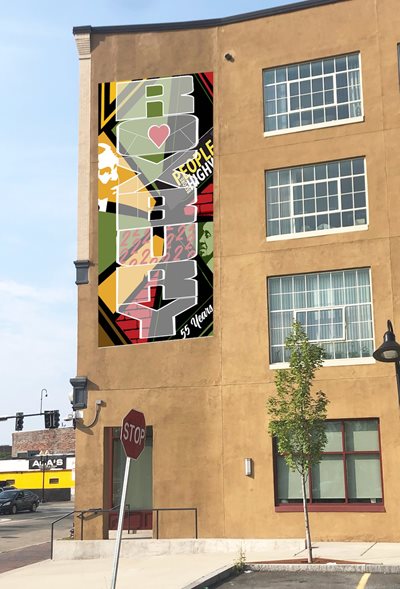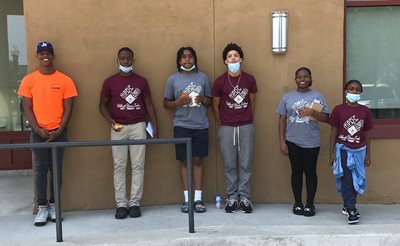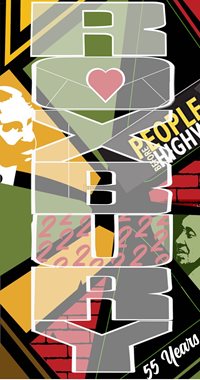In Boston, leaders are calling the mural a "love letter to Roxbury." Created in conjunction with Madison Park Development Corporation's 55th anniversary, a mobile mural is helping bring a cohesive spirit to the Nubian Square corridor. And that, says Kay Mathew, resource development manager, is exactly what public art is supposed to do.
 NeighborWorks network organizations across the country use art to bring communities together year round. During October, National Arts & Humanities Month, leaders encourage organizations, individuals and communities to highlight culture and participate in the arts.
NeighborWorks network organizations across the country use art to bring communities together year round. During October, National Arts & Humanities Month, leaders encourage organizations, individuals and communities to highlight culture and participate in the arts.
Madison Park's new mural, which currently hangs at 9 Williams Street, is one of several in Madison Park Village, where a coalition of residents often talks about the need for public art. There's also a mural on a high rise for seniors; another adorns the wall outside a local high school.
The mobile mural project began last summer, part of a program with Madison Park's youth. James Pierre, a public arts manager who has worked with youth on large scale design before, led them on a tour of Roxbury's murals. His job was to get the students to come up with a theme and concept and find an artist to help execute it. He also brought the students to listen to leaders, including Madison Park CEO Leslie Reid, talk about the community's history and the creation of Madison Park. The network organization formed in the 1960s when a group of activists fought against a highway that would have caused the destruction of Lower Roxbury.
"The young people conducted interviews and had a long list of questions," Mathew says. "The history was important." She shares that Madison Park thought making the mural mobile, by placing it a transparent fabric known as scrim, would be "a way to bring art to the various nooks and crannies of the neighborhood."
Ensuring that murals have representation is important to Pierre – and to the others working on the project. When Pierre was young, he recalls family drives from Cambridge to Roxbury to find the Haitian ingredients his parents used in cooking. A Roxbury mural of a Black construction worker greeted him every time.
"I would always look to see it. I remember how powerful it was," Pierre says. "I valued it for lots of reasons but the main one is that there weren't a lot of images in the greater Boston area of people who looked like me." The mobile mural uses geometric shapes and includes portraits of two of MPDC's founders, Ralph Smith and C. Vincent Haynes.
Sarah Parmenter, NeighborWorks America's director of community building, says community arts projects like the mobile mural are critical "to place keeping and to honoring a community's history and leaders. They have the opportunity to facilitate intergenerational community building and instill a sense of pride in younger generations."
Lance Searcy is part of that younger generation. A student involved in creating the mural, he says he never been involved in mural-making before. "I grew up always into art and sketches and when I was told what I would be doing, I couldn't pass up on a good offer," says Searcy. The best thing about the project? Going around Roxbury to study the existing murals. "I would always see murals, but I never thought about the meaning of them." Now, he says, he thinks about history and the people who created the art.
 Two professional artists, Luis Taforo and his partner, Geo, worked on the mural with the students and saw the project through. They settled on a street-art style, similar to other murals in the Madison Park corridor. They used chunky letters that gave the mural a "graffiti kind of look," something that excited the students who worked with them.
Two professional artists, Luis Taforo and his partner, Geo, worked on the mural with the students and saw the project through. They settled on a street-art style, similar to other murals in the Madison Park corridor. They used chunky letters that gave the mural a "graffiti kind of look," something that excited the students who worked with them.
"Murals, if they're done right, can have an enormous impact in uplifting the community," Taforo says. He tells the story of a mural he and Geo did together several years ago, where Geo depicted Tarforo as a mad scientist. One day when Taforo was walking down the street, a kid saw him and stared. "He points at me and he says, 'you're the mad scientist.' He was able to look at the mural, absorb it, and recognize me as someone in his community."
Tarforo also cites a wall inside Madison Park High School that students once kicked and punched. "It was full of holes," he says. The principal asked Taforo and Geo to paint a mural there. "Nobody's punched it since," he adds. "Murals in a community create a space; they create a vibrancy that plain concrete can't do."
10/08/2021

